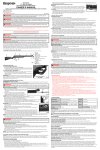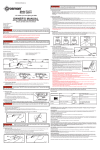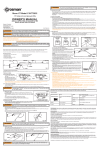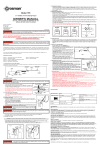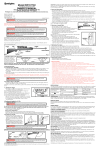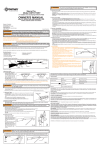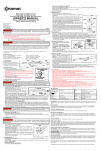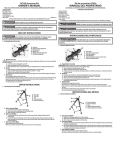Download Discovery OWNER`S MANUAL
Transcript
Discovery .177 and .22 caliber Pre-Charged Pneumatic Airgun OWNER’S MANUAL READ ALL INSTRUCTIONS AND WARNINGS IN THIS MANUAL BEFORE USING THIS AIRGUN Crosman Corporation 7629 Routes 5 & 20 East Bloomfield, NY 14443 www.crosman.com 1-800-7AIRGUN (724-7486) BP177A515 WARNING: Not a toy. This airgun is recommended for adult use only. Misuse or careless use may cause serious injury or death. May be dangerous up to 600 yards (549 meters). WARNING: Do not brandish or display this airgun in public—it may confuse people and may be a crime. Police and others may think it is a firearm. Do not change the coloration and markings to make it look more like a firearm. That is dangerous and may be a crime. YOU AND OTHERS WITH YOU SHOULD ALWAYS WEAR SHOOTING GLASSES TO PROTECT YOUR EYES. READ ALL INSTRUCTIONS BEFORE USING. BUYER AND USER HAVE THE DUTY TO OBEY ALL LAWS ABOUT THE USE AND OWNERSHIP OF THIS AIRGUN. THIS AIRGUN IS INTENDED FOR USE BY ADULTS ONLY WARNING: Lead pellets. Do not inhale dust or put pellets in mouth. Wash hands after handling. This product contains lead, a chemical known to the State of California to cause cancer and birth defects (or other reproductive harm.) WARNING: Use only compressed air in this airgun. When using Crosman’s optional CO2 adapter, you may use CO2. Use no other gasses—including oxygen, which can cause a fire or explosion that may result in serious injury or death. Please read this owner’s manual completely. And remember that an airgun is not a toy. Always carefully follow the safety instructions found in this owner’s manual and keep the manual in a safe place for future use. If you have any questions regarding the operation of your new airgun, please contact Crosman at 1-800-724-7486. • With the bolt in the rearward position, place one pellet, nose first, into the loading port (breech) (fig. 6). This is a single shot pellet airgun. Load no more than one pellet at a time. • Lightly push the pellet into the barrel by closing the bolt and pushing the bolt handle down to lock. DO NOT jam the bolt forward. This will damage your airgun. • Be sure the bolt is closed and locked before firing. If it is not closed and fully locked, the pellet may not be discharged. B. Unloading Pellets and Uncocking Your Air Gun Unloading • The most common way to unload a pellet is to fire your airgun in a SAFE DIRECTION following Section 5 on Aiming and Firing Safely. If a pellet has become lodged in the barrel follow the steps in section 6 Removing a Jammed Pellet. Un-cocking • To uncock the action, take the airgun “OFF SAFE.” With the muzzle pointed in a SAFE DIRECTION, open the bolt and pull all the way to the rear. Holding the bolt handle securely, pull the trigger with your other hand and slowly ease the bolt as far forward as it will go with your hand. You may now lower the bolt and the airgun is un-cocked. • Put the airgun “ON SAFE”. 5. Aiming and Firing Safely A. Aiming the Airgun • Always point your airgun in a SAFE DIRECTION. • Follow the instructions for filling the air gun (section 3A) and loading pellets (section 4A). • You and others with you should always wear shooting glasses to protect your eyes. • Do not shoot at hard surfaces or at the surface of water. The pellet may bounce off or ricochet and hit someone or something you had not intended to hit. • Always choose your target carefully. It is best to shoot at paper bull’s-eye targets which are attached to a safe backstop. A heavy blanket should be hung behind the backstop to prevent ricochet should you miss the backstop. • Your airgun is designed for target shooting and is suited for both indoor and outdoor use. Always remember to place your target carefully. THINK about what you will hit if you miss the target. • The airgun is correctly aimed when the front sight blade is positioned exactly in the center of the notch of the rear sight. The top of the front sight blade should be even with the top of the notch in the rear sight. The bulls-eye should appear to rest on the top of the front sight. • Before firing the airgun make certain there is sufficient pressure for proper operation. (see Figure 5). B. Adjusting the sights • The rear sight may be adjusted to shoot higher or lower (elevation). To move the point of impact up, turn the elevation screw clockwise. To move the point of impact down, turn the elevation screw counter-clockwise. • The rear sight may also be adjusted to shoot right or left (windage). Loosen the windage adjustment screw by turning counterclockwise. Move the sight to the right to move the point of impact to the right. Move the sight to the left to move the point of impact to the left. Tighten the windage adjustment screw by turning it clockwise. 6. Removing a Jammed Pellet A jammed pellet is usually the result of trying to fire the airgun when the pressure is too low. Before firing the airgun make certain there is sufficient pressure for proper operation. The gauge needle should be pointing to an area in the green zone on the gauge (see Figure 5). WARNING: In this procedure you will put a cleaning rod down the barrel of a charged airgun. It is extremely important that while you are doing this that the airgun be “ON SAFE”, the bolt remain in open position and that your finger be kept away from the trigger. Always keep the airgun pointed in a safe direction. Failure to follow this warning may result in serious injury or death. Operating procedures 1. Learning the Parts of Your New Airgun 2. Operating the Safety 3. Pressurizing and Depressurizing the Airgun (Section 3) 4. Cocking, Loading, Unloading and Uncocking the Airgun 5. Aiming and Firing Safely 6. Removing a Jammed Pellet 7. Maintaining Your Airgun 8. Reviewing Safety 1. Learning the Parts of your New Airgun Learning the names and parts of your new airgun will help you understand your owner’s manual. Graphic of airgun with following parts labeled: A. Bolt B. Safety C. Rear sight D. Front sight E. Protective cap for fill nipple F. Fill nipple G. Pressure gauge (Fig 5) H. Trigger I. Trigger guard J. Barrel K.Muzzle L. Stock Your new airgun is unique because it operates on either compressed air or CO2. To fill and shoot with CO2, an optional CO2 fill adapter must be purchased. This owner’s manual describes operating the gun with compressed air only. The manual that comes with Crosman’s CO2 adapter describes operation on CO2. 2. Operating the Safety A. To Put the Airgun “ON SAFE:” • Locate the safety directly in back of the trigger. • Push the safety from the left side all the way in (Fig. 2). The safety is not “ON SAFE” unless it is pushed all the way in and the RED ring around the left side of the safety is NOT showing. Like all mechanical devices, an airgun safety can fail. Even when the safety is “ON SAFE”, you should continue to handle the airgun safely. NEVER point the airgun at any person. NEVER point the airgun at anything you do not intend to shoot B. To Take the Airgun “OFF SAFE”: • Push the safety from the right side all the way in. • The airgun is ready to fire when “OFF SAFE.” When you can see the RED line on the left side of the safety, the airgun is “OFF SAFE” and can be fired. 3. Pressurizing and Depressurizing the Airgun A. Pressurizing (Filling) the Airgun [NOTE: Operation instructions for CO2 operation are contained in the manual that comes with the CO2 adapter] WARNING: Use only compressed air in this airgun. When using Crosman’s optional CO2 adapter, you may use CO2. Use no other gasses, including oxygen, which can cause a fire or explosion that may result in serious injury or death. • Be sure to wear eye protection • Make sure the airgun is unloaded and not cocked. (See step 4B. for instructions on uncocking and unloading.) • Read all instructions with your high pressure hand pump so you are familiar with its operation. Use only a pump designed for filling a pre-charged airgun. Do not use a standard “shop air” compressor as these types of air compressors cannot produce the high pressures required to operate the airgun. • Put the airgun “ON SAFE” (see step 2A). • Point the airgun in a SAFE DIRECTION. • Remove the cap that covers the fill nipple on the airgun. • Connect the quick-disconnect fitting on the hand pump hose to the fill nipple (fig. 3). • Make certain the bleed valve on the hand pump is fully closed (tighten in a clockwise direction) (fig.4). • Pressurize the airgun by pumping and continue until the gauge on the pump and the gauge on the airgun are at 2,000 psi. DO NOT fill the airgun to more than 2000 psi. See “Overfill” information below. • Open the bleed screw on the pump base in a counter-clockwise direction to bleed the hose. • Disconnect the pump from the fill nipple. • Place the cap over the fill nipple. Always keep the fill nipple capped to eliminate the possibility of dirt entering the check valve. Over Fill • This airgun is designed for optimal performance at a pressure no greater than 2,000 psi. Over filling does not improve performance. It will actually lessen performance and may cause the valve to lock. If you discover that the airgun has been over filled, try to dry fire the airgun (cock and shoot with no pellet loaded) in a SAFE DIRECTION until pressure on your airgun drops to 2,000 psi. • If the airgun will not discharge air with each shot the valve may be locked. In this case, contact Crosman Customer Service at 1-800-724-7486. WARNING: Do not attempt to repair the airgun or to disassemble to correct an over fill or valve lock. Parts can fly from the airgun at dangerous speeds when it is disassembled while pressurized. B. Depressurizing the Airgun • Keep the rifle pointed in a SAFE DIRECTION (see section 5A) • Remove all the air from your rifle by repeatedly cocking and dry-firing with the rifle pointed in a SAFE DIRECTION (see step 5A.) until the pressure gauge on your airgun shows no pressure on the gauge and air cannot be heard when the gun is dry fired. • Put the air gun “ON SAFE”. • If the pressure in the gun cannot be relieved by using the dry firing process it may indicate a valve lock condition. Contact Crosman customer service. • Alternatively, a special tool (Crosman part number PCPDT1) is available that will de-pressurize the gun. Contact Crosman customer service for information. 4. Cocking, Loading, Unloading and Uncocking the Airgun WARNING: Use .177 caliber pellets only in your .177 caliber Benjamin Discovery and .22 caliber pellets only in your .22 caliber Benjamin Discovery. Never reuse ammunition. Use of any other ammunition can cause injury to you or damage to the airgun. A. Cocking and Loading Pellets • Put the airgun “ON SAFE.” (See Section 2A) • Point the airgun in a SAFE DIRECTION. • Be sure your airgun is properly pressurized (see section 3). • Open the bolt by pushing the bolt handle up and pulling it all the way back until you hear two clicks. • Point the airgun in a SAFE DIRECTION. • Put the airgun “ON SAFE”. • Open the bolt by pushing the bolt handle up and pulling it all the way back until you hear two clicks. • With the bolt in the rearward position insert a ramrod of the proper size into the barrel (start at the muzzle). The barrel could be damaged if the proper sized cleaning rod is not used NOTE: The bolt must be cocked and open for the jammed pellet to clear the breech when it is pushed out by the ram rod. • Using the ramrod push the pellet into the pellet loading port (forward of the bolt), remove and discard the pellet. Do not reuse that pellet. • Point the airgun in a SAFE DIRECTION, close the action take “OFF SAFE” and fire. Put the airgun “ON SAFE”. • If you are not able to unjam your airgun by following this procedure, take no further action. Crosman Corporation or an Authorized Service Station will unjam your airgun. (no cost during the warranty period) 7. Maintaining Your Airgun • Put one drop of Crosman silicone chamber oil (part number RMCOIL) on the O-ring on the nose of the bolt every 6 months or every 2,000 shots. • DO NOT use petroleum-based lubricants with this airgun. • Keep all petroleum-based lubricants away from the fill nipple. They MUST NOT be introduced into the high pressure chamber. Use of petroleum-based lubricants in this area could result in an explosion resulting in personal injury. •DO NOT MODIFY OR ALTER YOUR AIRGUN. Attempts to modify the airgun in any way inconsistent with this manual may make your airgun unsafe to use, cause serious injury or death, and will void the warranty. •If you drop your airgun, visually check to see that it works properly before you use it again. If anything seems changed, like a shorter or weaker trigger pull, this may mean worn out or broken parts. Call Crosman customer service for assistance before using your airgun again. 8. Reviewing Safety • Never point the airgun at any person or at anything you do not intend to shoot. • Always treat the airgun as though it is loaded and with the same respect you would a firearm. • Always aim in a SAFE DIRECTION. Always keep the muzzle of the airgun pointed in a SAFE DIRECTION. • Always keep the airgun on safe until you are ready to shoot. • Always check to see if the airgun is “ON SAFE” and unloaded when getting it from another person or from storage. • Always keep your finger off the trigger and out of the trigger guard until ready to shoot. • You and others with you should always wear shooting glasses to protect your eyes. • If your reading or prescription glasses are not safety glasses, make sure you wear shooting glasses over your regular glasses. • Use .177 caliber (4.5mm) pellets only in your .177 caliber Benjamin Discovery or use .22 caliber (5.5 mm) pellets only in your .22 caliber Benjamin Discovery. Never reuse ammunition. Use of any other ammunition can cause injury to you or damage to the airgun. • Do not shoot at hard surfaces or at the surface of water. The pellet may bounce off or ricochet and hit someone or something you had not intended to hit. • Place the backstop in a location that will be safe should the backstop fail. • Your backstop should be checked for wear before and after each use. All backstops are subject to wear and will eventually fail. Replace your backstop if the surface is worn or damaged or if a ricochet occurs. • Do not attempt to disassemble or tamper with your airgun. Use an Authorized Service Station. Using unauthorized repair centers or modifying the function of your airgun in any way may be unsafe and will void your warranty. • Always keep your CrosBlock® trigger block in place when storing this airgun. Store the airgun in a secure location. (See CrosBlock instructions packaged with this airgun for assistance) • Before you store your airgun make sure it is not loaded or cocked. Store this airgun charged with compressed air or CO2 to keep the valves closed against dirt. • Whenever you store the airgun, make sure it is “ON SAFE.” SPECIFICATIONS Mechanism Bolt action single shot Power source Compressed air or CO2 (CO2 requires an optional fill adapter) Caliber/ammunition Model BP1K77 - .177 caliber lead pellet Model BP9M22 - .22 caliber lead pellet Weight 5.2 lbs Length 39 inches Barrel Rifled steel Safety Cross bolt REPAIR SERVICE If your airgun needs repair, we recommend you take or send it to your nearest Crosman Authorized Service Station. DO NOT ATTEMPT TO DISASSEMBLE IT! Your airgun requires special tools and fixtures to repair it. Any disassembly or modification not performed by an Authorized Service Station will void the warranty. A SPECIAL CUSTOMER SERVICE Crosman Authorized Service Stations will unjam your airgun at no cost during the warranty period. LIMITED ONE YEAR WARRANTY This product is warranted to the retail consumer for one year from date of retail purchase against defects in material and workmanship and is transferable. To register the serial number of your airgun, please return the airgun registration form. The warranty is not conditioned on the return of the card. You should retain the original sales receipt as record of date of purchase. WHAT IS COVERED Replacement parts and labor. Transportation charges to consumer for repaired product. WHAT IS NOT COVERED Transportation charges to Authorized Service Station for defective product. Damages caused by abuse, modification or failure to perform normal maintenance – see Owner’s Manual. Any other expense. CONSEQUENTIAL DAMAGES, INCIDENTAL DAMAGES, OR INCIDENTAL EXPENSES INCLUDING DAMAGE TO PROPERTY. SOME STATES DO NOT ALLOW THE EXCLUSION OR LIMITATION OF INCIDENTAL OR CONSEQUENTIAL DAMAGES SO THE ABOVE LIMITATION OR EXCLUSION MAY NOT APPLY TO YOU. HOW TO OBTAIN WARRANTY PERFORMANCE U.S. Customers- Locate nearest service station (see www.Crosman.com or call Crosman customer service at 800-724-7486 for list of stations). The service station will give you details of how to proceed with sending the item in for repair. You must contact the station prior to shipping your product. International Customers- Please return product to your nearest distributor. If you do not know your distributor, please call 585657-6161 and ask for our International Department for assistance. IMPLIED WARRANTIES ANY IMPLIED WARRANTIES INCLUDING THE IMPLIED WARRANTIES OF MERCHANTABILITY AND FITNESS FOR A PARTICULAR PURPOSE ARE LIMITED IN DURATION TO ONE YEAR FROM DATE OF RETAIL PURCHASE. SOME STATES DO NOT ALLOW LIMITATIONS ON HOW LONG AN IMPLIED WARRANTY LASTS SO THE ABOVE LIMITATIONS MAY NOT APPLY TO YOU. To the extent any provision of this warranty is prohibited by federal, state or municipal law, which cannot be preempted, it shall not be applicable. This warranty gives you specific legal rights and you may also have other rights, which vary, from state to state. CROSMAN and CROSBLOCK are registered trademarks of Crosman Corporation in the United States. Discovery • Alternativamente, hay disponible una herramienta especial (número de pieza de Crosman PCPDT1) para despresurizar el rifle. Comuníquese con servicio al cliente de Crosman para obtener información. 4. Amartillado, carga, descarga y desamartillado del rifle de aire calibre .177 y .22 Rifle de aire neumático precargado MANUAL DEL PROPIETARIO LEA TODAS LAS INSTRUCCIONES Y ADVERTENCIAS DE ESTE MANUAL ANTES DE USAR ESTE RIFLE DE AIRE Crosman Corporation 7629 Routes 5 & 20 East Bloomfield, NY 14443 www.crosman.com 1-800-7AIRGUN (724-7486) No es un juguete. Este rifle de aire se recomienda sólo para ser usado por adultos. El uso incorrecto o con descuido puede causar lesiones graves o la muerte. Puede ser peligroso hasta a 549 metros (600 yardas). No blanda ni muestre este rifle de aire en público; puede confundir a la gente y podría ser un delito. La policía y otras personas pueden pensar que se trata de un arma de fuego. No cambie la coloración o las marcas de modo que tenga un mayor parecido con un arma de fuego. Es peligroso y podría tratarse de un delito. USTED Y LAS DEMÁS PERSONAS DEBEN USAR SIEMPRE LENTES DE TIRO PARA PROTEGER SUS OJOS. LEA TODAS LAS INSTRUCCIONES ANTES DE USARLO. EL COMPRADOR Y EL USUARIO TIENEN EL DEBER DE OBEDECER TODAS LAS LEYES RELATIVAS AL USO Y A LA PROPIEDAD DE ESTE RIFLE DE AIRE. Por favor, lea por completo este manual del usuario. Y recuerde que un rifle de aire no es un juguete. Siempre siga cuidadosamente las instrucciones de seguridad que se encuentran en este manual del propietario y consérvelo en lugar seguro para utilizarlo en el futuro. Si tiene preguntas sobre su nuevo rifle de aire, comuníquese con Crosman al 1-800-724-7486. ESTE RIFLE DE AIRE SE RECOMIENDA SÓLO PARA SER USADO POR ADULTOS Diábolos de plomo. No inhale el polvo ni se ponga los diábolos en la boca. Lávese las manos después de manipularlo. Este producto contiene plomo, que en el Estado de California se ha determinado que causa cáncer y defectos congénitos (u otros daños a la reproducción) Use únicamente aire comprimido en este rifle de aire. Al usar el adaptador opcional de CO2 de Crosman, puede usar CO2. No use otros gases, entre ellos el oxígeno, que puedan causar un incendio o explosión y dar como resultado graves lesiones o la muerte. Procedimientos de operación 1. Aprender las partes de su nuevo rifle de aire 2. Operación del seguro 3. Presurizar y despresurizar el rifle de aire 4. Amartillado, carga, descarga y desamartillado del rifle de aire 5. Apuntar y disparar con seguridad 6. Extracción de un diábolo atorado 7. Mantenimiento del rifle de aire 8. Revisión de la seguridad 1. Aprender las partes de su nuevo rifle de aire Aprenderse los nombres de las partes de su nuevo rifle de aire le ayudará a entender el manual del propietario. Gráfico del rifle de aire con las siguientes partes etiquetadas: A. Cerrojo B. Seguro C. Mira trasera D. Mira delantera E. Tapón protector del niple de llenado (debe estar quitado en el dibujo) F. Niple de llenado G. Medidor de presión H. Gatillo I. Guardamonte J. Cañón K. Boca L. Culata Su nuevo rifle de aire es singular porque funciona ya sea con aire comprimido o con CO2. Para llenarlo y dispararlo con CO2, debe adquirirse un adaptador de llenado de CO2 opcional. Este manual del propietario describe únicamente el funcionamiento del rifle con aire comprimido. El manual que viene con el adaptador de CO2 de Crosman describe el funcionamiento con CO2. 2. Operación del seguro A. Para poner el seguro del rifle de aire en posición de activado (“ON SAFE”): • Encuentre el seguro que está directamente detrás del gatillo. • Empuje el seguro desde el lado izquierdo introduciéndolo por completo (Fig. 2). El seguro no está “ON SAFE” (no está activado) a menos que se haya presionado completamente hacia dentro y NO se vea el anillo ROJO que está alrededor del lado izquierdo del seguro. Como todos los dispositivos mecánicos, el seguro de las armas de aire puede fallar. Incluso con el seguro activado (“ON SAFE”), debe seguir manipulando con seguridad el rifle de aire. NUNCA apunte el rifle de aire a una persona. NUNCA apunte con el rifle de aire a nada a lo que no tenga intención de dispararle B. Para poner el seguro del rifle de aire en posición de desactivado (“OFF SAFE”): • Empuje totalmente hacia dentro el seguro desde el lado derecho. • El rifle de aire está listo para disparar cuando se desac tiva el seguro (“OFF SAFE”). Cuando puede ver la línea ROJA del lado izquierdo del seguro, el rifle de aire tiene el seguro desactivado (“OFF SAFE”) y puede dispararse. 3. Presurizar y despresurizar el rifle de aire A. Presurizar (llenar) el rifle de aire [NOTA: Las instrucciones de operación para el CO2 están contenidas en el manual que viene con el adaptador de CO2] Use únicamente aire comprimido en este rifle de aire. Al usar el adaptador opcional de CO2 de Crosman, puede usar CO2. No use otros gases, entre ellos el oxígeno, que puedan causar un incendio o explosión y dar como resultado graves lesiones o la muerte. • Asegúrese de utilizar protección para los ojos • Cerciórese de que el rifle de aire esté descargado y no amartillado. (Vea el paso 4.B. para obtener instrucciones sobre el desamartillado y la descarga.) • Lea todas las instrucciones que vienen con su bomba manual de alta presión para familiarizarse con su operación. Use únicamente una bomba diseñada para llenar un rifle de aire precargado. No utilice un compresor de aire es tándar “de taller”, ya que este tipo de compresores de aire no puede producir las altas presiones requeridas para hacer funcionar el rifle de aire. • Active el seguro del rifle de aire (“ON SAFE”) (vea el paso 2A). • Apunte el rifle de aire en una DIRECCIÓN SEGURA. • Quite el tapón que cubre el niple de llenado del rifle de aire. • Conecte el aditamento de desconexión rápida de la manguera de la bomba manual al niple de llenado (fig. 3). • Asegúrese de que la válvula de purga de la bomba de mano esté totalmente cerrada (apriétela en el sentido de las manecillas del reloj) (fig.4). • Presurice el rifle de aire bombeando y continúe hasta que el medidor de la bomba y el medidor del rifle de aire estén en 2,000 psi (fuera de las zonas roja y amarilla y en la zona verde del medidor montado en el rifle) NO llene el rifle de aire a más de 2,000 psi. Vea abajo la información sobre el llenado en exceso. • Abra el tornillo purgador de la base de la bomba girándolo en sentido contrario a las manecillas del reloj para purgar la manguera. Desconectar la manguera de llenado del rifle de aire sin purgar el aire primero puede ocasionar lesiones como resultado de la presión que queda en la manguera de llenado. • Desconecte la bomba del niple de llenado. • Coloque el tapón sobre el niple de llenado. Mantenga siempre el niple de llenado tapado para eliminar la posibilidad de que entre suciedad a la válvula reguladora. Llenado en exceso • Este rifle de aire está diseñado para un desempeño óptimo a una presión no mayor a los 2,000 psi. El llenado en exceso no mejora el desempeño. De hecho, puede disminuir el desempeño y ocasionar que se bloquee la válvula. Si descubre que se ha llenado en exceso el rifle de aire, intente dispararlo en vacío (amartille y dispare sin cargar diábolos) en una DIRECCIÓN SEGURA hasta que la presión de su rifle de aire caiga a 2,000 psi. • Si el rifle de aire no descarga aire con cada disparo, la válvula puede estar bloqueada. En este caso, comuníquese con Servicio al Cliente de Crosman al 1-800-724-7486. No intente reparar el rifle de aire ni desarmarlo para corregir un llenado en exceso o un bloqueo de válvula. Pueden salir piezas volando del rifle de aire a velocidades peligrosas cuando se desarma mientras está presurizado. B. Despresurizar el rifle de aire • Mantenga el rifle apuntado en una DIRECCIÓN SEGURA (vea la sección 5A) • Extraiga todo el aire de su rifle amartillando y disparando en vacío repetidamente con el rifle apuntado en una DIRECCIÓN SEGURA (vea el paso 5.A.), hasta que el medidor de presión de su rifle de aire muestre que no hay presión en el indicador y no se pueda escuchar aire cuando el rifle se dispara en vacío. • Active el seguro del rifle de aire (“ON SAFE”). • Si la presión del rifle no puede disminuirse con el proceso de disparo en vacío, esto puede indicar una situación de bloqueo de la válvula. Comuníquese con servicio al cliente de Crosman. Use solamente diábolos calibre .177 en su Benjamin Discovery calibre .177 y diábolos calibre .22 en su Benjamin Discovery calibre .22. Nunca reutilice la munición. El uso de cualquier otro tipo de munición puede causarle lesiones o dañar el rifle de aire. A. Amartillado y carga de los diábolos • Active el seguro del rifle de aire (“ON SAFE”). (Consulte la Sección 2A) • Apunte el rifle de aire en una DIRECCIÓN SEGURA. • Cuide que su rifle de aire esté debidamente presurizado (consulte la sección 3). • Abra el cerrojo empujando el mango de éste hacia arriba y tirando de él completamente hacia atrás, hasta que escuche dos clics. • Con el cerrojo en la posición hacia atrás, coloque un diábolo, empezando por la nariz, en el puerto de carga (recámara) (fig. 6). Éste es un rifle de aire de diábolos de un solo tiro. No cargue más de un diábolo a la vez. • Empuje ligeramente el diábolo al interior del cañón cerrando el cerrojo y empujando hacia abajo la manija para asegurarlo. NO trabe el cerrojo hacia delante. Esto podría dañar el rifle de aire. • Cuide que el cerrojo esté cerrado y asegurado antes de disparar. Si no está cerrado y completamente asegurado, podría no descargarse el diábolo. B. Descarga de los diábolos y desamartillado de su rifle de aire Descarga • La forma más común de descargar un diábolo es disparar el rifle de aire en una DIRECCIÓN SEGURA siguiendo las indicaciones de la sección 5 sobre Apuntar y disparar con seguridad. Si se atasca un diábolo en el cañón, siga los pasos de la sección 6 Extraer un diábolo atascado. Desamartillado • Para desamartillar la acción, desactive el seguro del rifle de aire (“OFF SAFE”). Con el cañón apuntando en una DIRECCIÓN SEGURA, abra el cerrojo y tire completamente hacia atrás. Sosteniendo firmemente el mango del cerrojo, tire del gatillo con su otra mano y lentamente lleve hacia delante con la mano el cerrojo tanto como avance. Ahora puede bajar el cerrojo y el rifle de aire estará desamartillado. • Ponga el rifle de aire “ON SAFE” (Seguro activado). 5. Apuntar y disparar con seguridad A. Apuntar el rifle de aire • Siempre apunte el rifle de aire en una DIRECCIÓN SEGURA. • Siga las instrucciones para llenar el rifle de aire (sección 3A) y cargar los diábolos (sección 4A). • Usted y las demás personas deben siempre usar anteojos de tiro para proteger sus ojos. • No dispare a superficies duras o a la superficie del agua. El diábolo puede rebotar y golpear a alguien o algo que usted no tenía intención de tocar. • Elija siempre su blanco con cuidado. Es mejor disparar contra dianas de papel que se hayan fijado a un respaldo seguro. Debe colgarse una manta gruesa detrás del respaldo para evitar rebotes en caso de que no atine al respaldo. • Su rifle de aire está diseñado para tiro al blanco y es adecuado para usarse bajo techo o al aire libre. Recuerde siempre colocar su blanco con cuidado. PIENSE en lo que puede golpear si no atina al blanco. • El rifle de aire está apuntado correctamente cuando la hoja de la mira delantera está posicionada exactamente en el centro de la muesca de la mira trasera. La parte superior de la hoja de la mira delantera debe estar nivelada con la parte superior de la muesca de la mira trasera. La diana debe verse como si descansara encima de la mira delantera. • Antes de disparar el rifle de aire, asegúrese de que hay suficiente presión para su operación correcta. La aguja del medidor debe estar apuntando a un área en la zona verde del medidor (vea la Figura 5). B. Ajuste de las miras • Se puede ajustar la mira trasera para tirar más alto o más bajo (elevación). Para subir el punto de impacto, gire el tornillo de elevación en el sentido de las manecillas del reloj. Para bajar el punto de impacto, gire el tornillo de elevación en sentido contrario al de las manecillas del reloj. • También se puede ajustar la mira trasera para disparar a la derecha o izquierda (compensación de viento). Afloje el tornillo de compensación de viento girándolo en sentido contrario al de las manecillas del reloj. Mueva la mira hacia la derecha para mover el punto de impacto a la derecha. Mueva la mira hacia la izquierda para mover el punto de impacto a la izquierda. Apriete el tornillo de ajuste de compensación de viento girándolo en el sentido de las manecillas del reloj. 6. Extracción de un diábolo atorado Un diábolo atascado es habitualmente el resultado de los intentos de disparar el rifle de aire con la presión demasiado baja. Antes de disparar el rifle de aire, asegúrese de que hay suficiente presión para su operación correcta. La aguja del medidor debe estar apuntando a un área en la zona verde del medidor (vea la Figura 5). En este procedimiento meterá una baqueta por el cañón de un rifle de aire cargado. Es en extremo importante que mientras esté haciendo esto el rifle de aire tenga el seguro activado (“ON SAFE”), que el cerrojo permanezca en posición abierta y que mantenga el dedo apartado del gatillo. Mantenga siempre el rifle de aire apuntado en una dirección segura. No respetar esta advertencia podría causar lesiones graves o la muerte. • Apunte el rifle de aire en una DIRECCIÓN SEGURA. • Ponga el rifle de aire “ON SAFE” (Seguro activado). • Abra el cerrojo empujando el mango de éste hacia arriba y tirando de él completamente hacia atrás, hasta que escuche dos clics. • Con el cerrojo en la posición hacia atrás, inserte una baqueta del tamaño adecuado en el cañón (empezando por la boca). Se puede dañar el cañón si no se usa una baqueta de limpieza del tamaño correcto. NOTA: El cerrojo debe estar amartillado y abierto para que el diábolo atascado salga de la recámara al empujarlo con la baqueta. • Con la baqueta, empuje el diábolo al puerto de carga de diábolos (delante del cerrojo), quite y deseche el diábolo. No vuelva a utilizar ese diábolo. • Apunte el rifle de aire en una DIRECCIÓN SEGURA, cierre la acción, desactive el seguro (póngalo en “OFF SAFE”) y dispare. Ponga el rifle de aire “ON SAFE” (Seguro activado). • Si no puede desatascar el rifle de aire siguiendo este procedimiento, no emprenda ninguna otra acción. Crosman Corporation o una Estación de Servicio Autorizada le desatascarán el rifle. (esto no tiene costo durante el período de garantía) 7. Mantenimiento del rifle de aire • Ponga una gota de aceite de recámara de silicona Crosman (número de pieza RMCOIL) en la junta tórica que está en la nariz del cerrojo cada 6 meses o cada 2,000 disparos. • NO use lubricantes con base de petróleo en este rifle de aire. • Mantenga todos los lubricantes con base de petróleo apartados del niple de llenado. NO DEBEN introducirse en la cámara de alta presión. El uso de lubricantes con base de petróleo en esta área podría dar como resultado una explosión que provoque lesiones personales. • NO MODIFIQUE NI ALTERE EL RIFLE DE AIRE. Los intentos de modificar el rifle de aire de cualquier forma que no esté indicada en este manual pueden hacer que el rifle de aire no sea seguro para usarse, ocasionar graves lesiones o la muerte, y anular la garantía. • Si su rifle de aire se cae, revise visualmente que funcione correctamente antes de volverlo a usar. Si parece que cualquier cosa ha cambiado, como que el gatillo esté más suave o más duro, puede ser indicación de piezas desgastadas o rotas. Llame a servicio al cliente de Crosman para obtener ayuda antes de volver a usar el rifle de aire. 8. Revisión de la seguridad • Nunca apunte el rifle de aire a ninguna persona o a ninguna cosa a la que no tenga intención de dispararle. • Siempre trate el rifle de aire como si estuviera cargado y con el mismo respeto que le tendría a un arma de fuego. • Apunte siempre en una DIRECCIÓN SEGURA. Mantenga siempre el cañón del rifle de aire apuntado en una DIRECCIÓN SEGURA. • Mantenga siempre el rifle de aire con el seguro activado hasta que esté listo para disparar. • Siempre compruebe que el rifle de aire tenga el seguro activado (“ON SAFE”) y esté descargado al recibirlo de otra persona o al sacarlo después de estar guardado. • Mantenga siempre el dedo apartado del gatillo y fuera del guardamonte hasta que esté listo para disparar. • Usted y las demás personas deben siempre usar anteojos de tiro para proteger sus ojos. • Si sus lentes de lectura o para ver no son de seguridad, asegúrese de usar anteojos de tiro sobre sus lentes normales. • Use solamente diábolos calibre .177 (4.5 mm) en su Benjamin Discovery calibre .177 o use diábolos calibre .22 (5.5 mm) en su Benjamin Discovery calibre .22. Nunca reutilice la munición. El uso de cualquier otro tipo de munición puede causarle lesiones o dañar el rifle de aire. • No dispare a superficies duras o a la superficie del agua. El diábolo puede rebotar y golpear a alguien o algo que usted no tenía intención de tocar. • Coloque el respaldo en un lugar que sea seguro en caso de que no le atine al respaldo. • Debe revisarse el desgaste del respaldo antes y después de cada uso. Todos los respaldos se desgastan y finalmente dejarán de servir. Reemplace el respaldo si la superficie está desgastada o dañada, o si rebota la munición. • No intente desarmar el rifle de aire ni lo manipule indebidamente. Use una Estación de Servicio Autorizada. El uso de centros de reparaciones no autorizados o la modificación de las funciones del rifle de aire en cualquier forma puede ser inseguro y anulará la garantía. • Conserve siempre el bloqueo del gatillo CrosBlock® en su sitio al guardar este rifle de aire. Guarde el rifle de aire en un sitio seguro. (Consulte las instrucciones del CrosBlock incluidas con este rifle de aire para obtener ayuda) • Antes de almacenar el rifle de aire, asegúrese de que no esté cargado, ni amartillado. Almacene este rifle de aire cargado con aire comprimido o CO2 para mantener las válvulas cerradas contra la suciedad. • Siempre que almacene el rifle de aire, asegúrese de que el seguro esté activado (“ON SAFE”). ESPECIFICACIONES Mecanismo Acción de cerrojo de un solo tiro Fuente de energía Aire o CO2 comprimidos (el CO2 requiere un adaptador de llenado opcional) Calibre/Municiones Modelo BP1K77: diábolo de plomo cal. .177 Modelo BP9M22: diábolo de plomo cal. .22 Peso 5.2 libras Longitud 39 pulgadas Cañón Acero estriado Seguro Perno cruzado SERVICIO DE REPARACIONES Si el rifle de aire necesita repararse, le recomendamos que lo lleve o envíe a su Estación de Servicio Autorizada Crosman más cercana. ¡NO INTENTE DESARMARLO! El rifle de aire requiere de herramientas y accesorios especiales para repararlo. Si el desmontaje o la modificación no los realiza una Estación de Servicio Autorizada, se anulará la garantía. UN SERVICIO ESPECIAL AL CLIENTE Las Estaciones de Servicio Autorizadas Crosman desatascarán el rifle de aire sin costo durante el período de garantía. GARANTÍA LIMITADA DE UN AÑO Este producto está garantizado para el comprador al menudeo durante un año a partir de la fecha de compra al menudeo contra defectos en materiales y mano de obra, y es transferible. Para registrar el número de serie de su rifle, devuelva el formulario de registro de armas de aire. La garantía no está condicionada a la devolución de la tarjeta. Debe conservar el recibo de ventas original como registro de la fecha de compra. QUÉ ESTÁ CUBIERTO Refacciones y mano de obra. Cargos del transporte del producto reparado al consumidor. QUÉ NO ESTÁ CUBIERTO Cargos de transporte del producto defectuoso a la Estación de Servicio Autorizada. Daños ocasionados por el abuso, modificación o negligencia en la realización del mantenimiento normal, consulte el Manual del Propietario. Cualquier otro gasto. DAÑOS CONSECUENCIALES, INCIDENTALES, O GASTOS INCIDENTALES INCLUIDOS LOS DE DAÑOS A LA PROPIEDAD. ALGUNOS ESTADOS NO PERMITEN LA EXCLUSIÓN O LIMITACIÓN DE DAÑOS INCIDENTALES O CONSECUENCIALES, DE MODO QUE ES POSIBLE QUE LA LIMITACIÓN O EXCLUSIÓN ANTES SEÑALADA NO SE LE APLIQUE A USTED. CÓMO HACER EFECTIVA LA GARANTÍA Clientes de los EE. UU.: Encuentre la estación de servicio más cercana (visite www.Crosman.com o llame a servicio al cliente de Crosman al 800-724-7486 para obtener una lista de estaciones). La estación de servicio le dará los detalles sobre cómo proceder con el envío del artículo para su reparación. Debe ponerse en contacto con la estación antes de enviar el producto. Clientes internacionales: Devuelva el producto a su distribuidor más cercano. Si no conoce a su distribuidor, llame al 585-657-6161 y pida hablar con nuestro Departamento Internacional (International Department) para obtener ayuda. GARANTÍAS IMPLÍCITAS CUALESQUIERA GARANTÍAS IMPLÍCITAS, INCLUIDAS LAS GARANTÍAS IMPLÍCITAS DE COMERCIABILIDAD Y ADECUACIÓN PARA UN PROPÓSITO EN PARTICULAR, TIENEN UNA DURACIÓN LIMITADA DE UN AÑO A PARTIR DE LA FECHA DE LA COMPRA AL MENUDEO. ALGUNOS ESTADOS NO PERMITEN LIMITACIONES SOBRE LA DURACIÓN DE UNA GARANTÍA IMPLÍCITA, DE MODO QUE ES POSIBLE QUE ESTAS LIMITACIONES NO SE LE APLIQUEN A USTED. En la medida en que cualquier disposición de esta garantía esté prohibida por la ley federal, estatal o municipal, que no pueda adelantarse, no será aplicable. Esta garantía le otorga derechos legales concretos y es posible que usted tenga también otros derechos que varían según el estado. CROSMAN y CROSBLOCK son marcas comerciales registradas de Crosman Corporation en los Estados Unidos.


